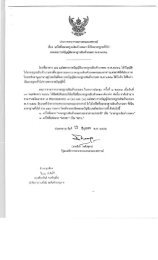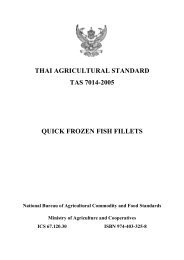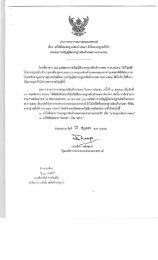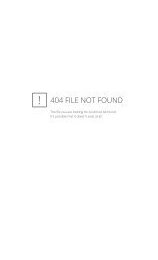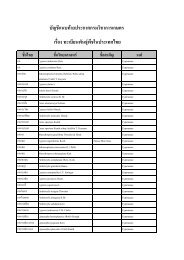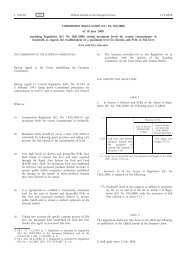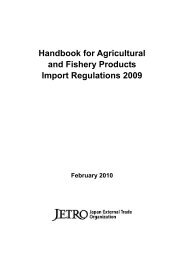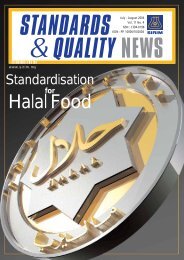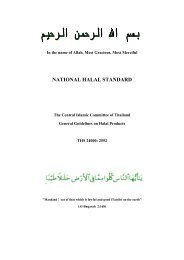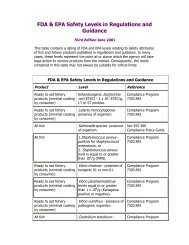Onions
Onions
Onions
Create successful ePaper yourself
Turn your PDF publications into a flip-book with our unique Google optimized e-Paper software.
THAI AGRICULTURAL STANDARD<br />
TAS 1510-2008<br />
ONION<br />
National Bureau of Agricultural Commodity and Food Standards<br />
Ministry of Agriculture and Cooperatives<br />
ICS 67.080.20 ISBN 978-974-403-537-0
UNOFFICAL TRANSLATION<br />
THAI AGRICULTURAL STANDARD<br />
TAS 1510-2008<br />
ONION<br />
National Bureau of Agricultural Commodity and Food Standards<br />
Ministry of Agriculture and Cooperatives<br />
50 Phaholyothin Road, Ladyao, Chatuchak, Bangkok 10900<br />
Telephone (662) 561 2277 www.acfs.go.th<br />
Published in the Royal Gazette Vol.125 Section 139D,<br />
dated 18 August B.E. 2551 (2008)
(2)<br />
Ad hoc Sub Committee on the Elaboration of Standard for Onion<br />
1. Director General of the Department of Agriculture or representative Chairperson<br />
Mr. Suchat Vichitananda, Representative of Director General<br />
2. Representative of the Department of Agricultural Extension<br />
Mrs. Orasa Dissataporn<br />
3. Representative of the Cooperatives Promotion Department<br />
Mr. Phatnithi Waseeweerasi<br />
Mr. Suvisid Chotputtikul (alternate)<br />
4. Representative of the National Bureau of Agricultural Commodity and Food Standards<br />
Mrs. Oratai Silapanapaporn<br />
Mr. Pisan Pongsapitch (alternate)<br />
5. Representative of the Horticulture Research Institute<br />
Mrs. Pitsawat Buara<br />
6. Representative of the Faculty of Agriculture, Kasetsart University<br />
Ms. Pariyanuj Chulaka<br />
7. Representative of the Thai Chamber of Commerce<br />
8. Representative of the Horticultural Science Society of Thailand<br />
Mr. Suraphong Kosiyachinda<br />
9. Representative of the Thai Food Processors’ Association<br />
Mr. Sunthorn Wattanaporn<br />
Mrs. Pranee Srisomboon (alternate)<br />
10. Representative of the Thai Fruit and Vegetable Producer Association<br />
Mr. Pathom Taenkam<br />
11. Experts<br />
Assistant Professor Nipon Jayamangkala<br />
Mr. Kanit Likhitvidhayavuth<br />
Mr. Preecha Borsub<br />
12. Representative of the Office of Commodity and System Standards, Secretary<br />
National Bureau of Agricultural Commodity and Food Standards<br />
Mrs. Voranuch Kitsukchit<br />
13. Representative of the Office of Commodity and System Standards, Assistant Secretary<br />
National Bureau of Agricultural Commodity and Food Standards<br />
Ms. Yaninsiri Tinnakorn
(3)<br />
Onion is a Thai agricultural commodity which has a high potential in the production and<br />
export. The establishment of a standard for this commodity is important for promoting and<br />
encouraging the development of production in terms of both quality and safety . Therefore, it<br />
is deemed necessary for the Ministry of Agriculture and Cooperatives to establish the<br />
standard on onion so as to be reliable and recognized both domestically and internationally.<br />
More importantly, it will be of great benefits for consumers’ safety as well as for export<br />
promotion.<br />
The provisions of this standard are based on the information of the following documents:<br />
The Study on the Produce of Important Characteristic Indices which are used as Criteria for<br />
Quality Classification and Size Code Determination of the Onion Project of the National<br />
Bureau of Agricultural Commodity and Food Standards B.E. 2549 (2006) in cooperation with<br />
Kasetsart University.<br />
UNECE 2003. The UNECE Standard for <strong>Onions</strong> (UNECE STANDARD FFV-25).<br />
The United Nations Economic Commission for Europe.<br />
Remark:<br />
The standard title has been revised from “Thai Agricultural Commodity and Food Standard<br />
(TACFS)” to “Thai Agricultural Standard (TAS)” in accordance with the enforcement of the<br />
Agricultural Standards Act B.E. 2551 (2008).
NOTIFICATION OF THE NATIONAL COMMITTEE ON<br />
AGRICULTURAL COMMODITY AND FOOD STANDARDS<br />
SUBJECT: THAI AGRICULTURAL COMMODITY AND FOOD STANDARD :<br />
ONION<br />
B.E. 2551 (2008)<br />
The resolution of the 1/2551 session of the National Committee on Agricultural<br />
Commodity and Food Standards dated 11 August B.E. 2551 (2008) endorsed the Thai<br />
Agricultural Commodity and Food Standard entitled Onion for the benefit of development of<br />
agricultural commodity and food which is safe and in accordance with the standard.<br />
By virtue of the Cabinet Resolution on Appointment and Authorization of the National<br />
Committee on Agricultural Commodity and Food Standards dated 5 August B.E. 2551 (2008),<br />
the Notification on Thai Agricultural Commodity and Food Standard entitled Onion is hereby<br />
issued as voluntary standard, the details of which are attached herewith.<br />
Notified on 14 August B.E. 2551 (2008)<br />
Mr. Somsak Prissana-nanthakul<br />
Minister of Agriculture and Cooperatives<br />
Chairperson of the National Committee on Agricultural Commodity and Food Standards
TAS 1510-2008<br />
THAI AGRICULTURAL STANDARD<br />
ONION<br />
1 SCOPE<br />
This standard applies to commercial varieties of onion grown from Allium cepa L. of the<br />
Alliaceae family, to be supplied for consumption after preparation and packing, but excluding<br />
those for processing.<br />
2 QUALITY<br />
2.1 MINIMUM REQUIREMENTS<br />
1.1.1 In all classes, subject to the special provisions for each class and the tolerances<br />
allowed, the onion shall be:<br />
(1) whole,<br />
(2) leaf base or neck is sufficiently dry in accordance with the use objectives,<br />
(3) practically free of sprouting and/or rooting,<br />
(4) clean, practically free of any visible foreign matter,<br />
(5) free of damage caused by high and low temperature and/or frost,<br />
(6) practically free of twin bulbs and/or visibly abnormal characteristics,<br />
(7) practically free of soft bulb or rotting or bruising evidence such as to make it unfit for<br />
consumption,<br />
(8) practically free of pests affecting the general appearance of the produce,<br />
(9) practically free of produce damage caused by pests,<br />
(10) free of any foreign smell and/or abnormal taste, and<br />
(11) leaf shall be cut off with remained part not exceeding 6 cm and the root shall be<br />
trimmed off.<br />
2.1.2 The onion shall be properly mature, appropriate to the variety and geographical<br />
location. They shall be carefully harvested, postharvest handled, packed and transported in<br />
order to obtain the produce in acceptable condition on arrival at the destination.<br />
2.2 CLASSIFICATION<br />
The onion in this standard is classified in two classes defined below:<br />
2.2.1 Class I<br />
The onion in this class shall be of good quality and characteristics in respect of shape and<br />
color of the variety, firm bulb, the outer skin is dry and complete. In case of defects, slight<br />
defects in shape and skin color are allowed; provided these do not affect the general<br />
appearance of the produce, the quality, the keeping quality and presentation in the package.
TAS 1510-2008 2<br />
2.2.2 Class II<br />
This class includes onions which do not qualify for inclusion in the higher class, but satisfy<br />
the minimum requirements specified in Section 2.1. Slight defects in shape, skin color, scars<br />
or superficial bruising and crack lesions on the skin are allowed, provided these do not affect<br />
the general appearance of the produce, the quality, the keeping quality and the presentation in<br />
the package.<br />
3 SIZING<br />
The onion size is determined by its diameter measured at the widest part of the bulb as the<br />
followings:<br />
Table 1 Onion Size<br />
Size Code Diameter ( cm )<br />
1 > 9.0<br />
2 >8.0 to 9.0<br />
3 >7.0 to 8.0<br />
4 >6.0 to 7.0<br />
5 >5.0 to 6.0<br />
6 >4.0 to 5.0<br />
7 3.0 to 4.0<br />
The classification and provisions concerning sizing in this standard may be applied in the<br />
trade deal. The classification may be jointly implemented with the sizing provisions in order<br />
to provide the trade grading which the trading partners may call it differently. This depends<br />
on the requirements of the trading partners or the seasonal limitation.<br />
4 TOLERANCES<br />
Tolerances in respect of quality and size shall be allowed for produce in each package not<br />
satisfying the requirements of the class indicated.<br />
4.1 QUALITY TOLERANCES<br />
4.1.1 Class I<br />
Not more than 5% by number of onion bulbs not satisfying the requirements of Class I, but<br />
meeting those of Class II, or coming within the tolerances of Class II.<br />
4.1.2 Class II<br />
Not more than 5% by number of onion bulbs satisfying neither the requirements of Class II<br />
nor the minimum requirements, but it shall exclude onions that are unfit for consumption.
3<br />
TAS 1510-2008<br />
4.2 SIZE TOLERANCE<br />
Not more than 5% by number of all size codes of onions falling within the size immediately<br />
above or below those indicated in Section 3.<br />
5 PACKING AND PRESENTATION<br />
5.1 UNIFORMITY<br />
The contents of each package shall be uniform in respect of variety, quality, size, and color.<br />
The visible part of onion in the package shall be representative of the entire contents.<br />
5.2 PACKAGING<br />
The onion shall be packed in such a way as to maintain the quality of the produce properly.<br />
The materials used inside the package shall be clean and of a quality to protect the onion<br />
from any damage affecting its quality. The use of materials, in particular paper or stamps<br />
bearing trade specifications is allowed, provided that the printing or labeling has been done<br />
with a non-toxic ink or glue. Label individually affixed on an onion bulb shall be such that,<br />
when removed, neither leave visible traces of glue, nor lead to skin defects.<br />
5.3 DESCRIPTION OF CONTAINERS<br />
The containers shall be of good quality, hygiene, good ventilation, free of abnormal smell and<br />
foreign matter, and have resistant characteristics to withstand transportation and preserve the<br />
produce.<br />
6 MARKING AND LABELLING<br />
6.1 CONSUMER PACKAGES<br />
Each package shall bear the following particulars, legible, and without false or deceptive<br />
information.<br />
(1) Nature of Produce<br />
The word of “Onion” shall be indicated,<br />
(2) Day/month/year of Packing,<br />
(3) Net weight in gram or kilogram,<br />
(4) Producer’s and Distributor’s information<br />
Name and site address of producer or re-packer or distributor and operation site. Name and<br />
address of the head office of the producer or of the re-packer may be labeled. In case of<br />
import, there shall be name and site address of the importer,<br />
(5) Origin of produce<br />
Indicate country of origin, except the onion domestically produced for local market,<br />
(6) Language
TAS 1510-2008 4<br />
Label of produce shall be in Thai. Produce label for export can be in any language, and<br />
(7) If the produce is irradiated, it shall be indicated on the label.<br />
6.2 NON-RETAIL CONTAINERS<br />
Each container shall bear statement indicated in the accompanying document, labels or<br />
displayed on the container. The statement shall be legible, indelible and without false or<br />
deceptive information as followings:<br />
(1) Nature of Produce<br />
The word of “Onion” shall be indicated,<br />
(2) Class,<br />
(3) Size, if classified by size,<br />
(4) Net weight in gram or kilogram,<br />
(5) Producer’s and Distributor’s Information<br />
Name and site address of producer or re-packer or distributor and commercial identification<br />
code (if any). Name and address of the head office of the producer or of the re-packer may be<br />
labeled. In case of import, there shall be name and site address of the importer,<br />
(6) Origin of produce<br />
Indicate country of origin, except the onion domestically produced for local market,<br />
(7) Language<br />
Label of produce shall be in Thai. Produce label for export can be in any language, and<br />
(8) If the produce is irradiated, it shall be indicated on the label.<br />
6.3 CERTIFICATION MARK<br />
Certification mark of this standard shall be complied with criteria and conditions provided by<br />
the Committee on Agricultural Standards.<br />
7 CONTAMINANTS<br />
In compliance with the provisions of the relevant laws and requirements under the Thai<br />
Agricultural Standard on Contaminants.<br />
8 PESTICIDE RESIDUES<br />
In compliance with the provisions of the relevant laws and requirements under the Thai<br />
Agricultural Standard on Pesticide Residues: Maximum Residue Limits (TAS 9002) and<br />
Pesticide Residues: Extraneous Maximum Residue Limits (TAS 9003).
5<br />
TAS 1510-2008<br />
9 HYGIENE<br />
Harvesting, handlings including storage, packing and transportation shall be hygienically<br />
practiced in order to prevent any contaminations which will be harmful to the consumer.<br />
10 METHODS OF ANALYSIS AND SAMPLING<br />
In compliance with the provisions of the relevant laws and requirements under the Thai<br />
Agricultural Standard on Analytical and Sampling Methods.
TAS 1510-2008 6<br />
ANNEX A<br />
ONION ILLUSTRATION<br />
Figure A1 Onion bulb with complete skin<br />
and dry neck<br />
Figure A2 Slightly crack of the skin<br />
Figure A3 Late sprouting Figure A4 Rooting
7<br />
TAS 1510-2008<br />
Figure A5<br />
External damages caused by mold<br />
Figure A6 Internal damages caused Figure A7 External rotting<br />
by pests
TAS 1510-2008 8<br />
ANNEX B<br />
UNIT<br />
The unit and symbol used in this standard and the unit of SI (International System of Units or<br />
Le Système International d’Unités) recognized to be used are as follows:<br />
Measurement Unit Symbols<br />
Length centimeter cm




